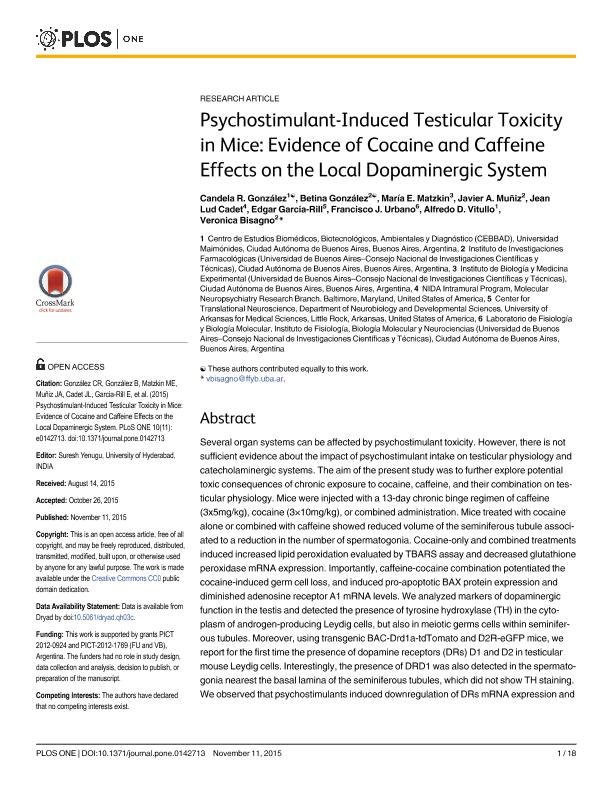Mostrar el registro sencillo del ítem
dc.contributor.author
Gonzalez, Candela Rocio

dc.contributor.author
Gonzalez, Betina

dc.contributor.author
Matzkin, Maria Eugenia

dc.contributor.author
Muñiz, Javier A.
dc.contributor.author
Cadet, Jean Lud
dc.contributor.author
Garcia Rill, Edgar
dc.contributor.author
Urbano Suarez, Francisco Jose

dc.contributor.author
Vitullo, Alfredo Daniel

dc.contributor.author
Bisagno, Veronica

dc.date.available
2017-03-08T17:53:33Z
dc.date.issued
2015-11
dc.identifier.citation
Gonzalez, Candela Rocio; Gonzalez, Betina; Matzkin, Maria Eugenia; Muñiz, Javier A.; Cadet, Jean Lud; et al.; Caffeine potentiates cocaine-induced testicular toxicity in mice: evidence of psychostimulant-mediated effects on the local dopaminergic system; Public Library Of Science; Plos One; 10; 11; 11-2015; e0142713
dc.identifier.issn
1932-6203
dc.identifier.uri
http://hdl.handle.net/11336/13632
dc.description.abstract
Several organ systems can be affected by psychostimulant toxicity. However, there is not sufficient evidence about the impact of psychostimulant intake on testicular physiology and catecholaminergic systems. The aim of the present study was to further explore potential toxic consequences of chronic exposure to cocaine, caffeine, and their combination on testicular physiology. Mice were injected with a 13-day chronic binge regimen of caffeine (3x5mg/kg), cocaine (3×10mg/kg), or combined administration. Mice treated with cocaine alone or combined with caffeine showed reduced volume of the seminiferous tubule associated to a reduction in the number of spermatogonia. Cocaine-only and combined treatments induced increased lipid peroxidation evaluated by TBARS assay and decreased glutathione peroxidase mRNA expression. Importantly, caffeine-cocaine combination potentiated the cocaine-induced germ cell loss, and induced pro-apoptotic BAX protein expression and diminished adenosine receptor A1 mRNA levels. We analyzed markers of dopaminergic function in the testis and detected the presence of tyrosine hydroxylase (TH) in the cytoplasm of androgen-producing Leydig cells, but also in meiotic germs cells within seminiferous tubules. Moreover, using transgenic BAC-Drd1a-tdTomato and D2R-eGFP mice, we report for the first time the presence of dopamine receptors (DRs) D1 and D2 in testicular mouse Leydig cells. Interestingly, the presence of DRD1 was also detected in the spermatogonia nearest the basal lamina of the seminiferous tubules, which did not show TH staining. We observed that psychostimulants induced downregulation of DRs mRNA expression and upregulation of TH protein expression in the testis. These findings suggest a potential role of the local dopaminergic system in psychostimulant-induced testicular pathology.
dc.format
application/pdf
dc.language.iso
eng
dc.publisher
Public Library Of Science

dc.rights
info:eu-repo/semantics/openAccess
dc.rights.uri
https://creativecommons.org/licenses/by/2.5/ar/
dc.subject
Caffeine
dc.subject
Cocaine
dc.subject
Dopamine
dc.subject
Adenosine
dc.subject
Spermatogenesis
dc.subject
Tyrosine Hydroxylase
dc.subject.classification
Bioquímica y Biología Molecular

dc.subject.classification
Medicina Básica

dc.subject.classification
CIENCIAS MÉDICAS Y DE LA SALUD

dc.title
Caffeine potentiates cocaine-induced testicular toxicity in mice: evidence of psychostimulant-mediated effects on the local dopaminergic system
dc.type
info:eu-repo/semantics/article
dc.type
info:ar-repo/semantics/artículo
dc.type
info:eu-repo/semantics/publishedVersion
dc.date.updated
2017-03-07T15:21:47Z
dc.journal.volume
10
dc.journal.number
11
dc.journal.pagination
e0142713
dc.journal.pais
Estados Unidos

dc.journal.ciudad
San Francisco
dc.description.fil
Fil: Gonzalez, Candela Rocio. Universidad Maimónides. Area de Investigaciones Biomédicas y Biotecnológicas. Centro de Estudios Biomédicos, Biotecnológicos, Ambientales y de Diagnóstico; Argentina. Consejo Nacional de Investigaciones Científicas y Técnicas; Argentina
dc.description.fil
Fil: Gonzalez, Betina. Consejo Nacional de Investigaciones Científicas y Técnicas. Oficina de Coordinación Administrativa Houssay. Instituto de Investigaciones Farmacológicas (i); Argentina
dc.description.fil
Fil: Matzkin, Maria Eugenia. Consejo Nacional de Investigaciones Científicas y Técnicas. Instituto de Biología y Medicina Experimental (i); Argentina
dc.description.fil
Fil: Muñiz, Javier A.. Consejo Nacional de Investigaciones Científicas y Técnicas. Oficina de Coordinación Administrativa Houssay. Instituto de Investigaciones Farmacológicas (i); Argentina
dc.description.fil
Fil: Cadet, Jean Lud. National Institute on Drug Abuse ; Estados Unidos
dc.description.fil
Fil: Garcia Rill, Edgar. University Of Arkansas For Medical Sciences; Estados Unidos
dc.description.fil
Fil: Urbano Suarez, Francisco Jose. Consejo Nacional de Investigaciones Científicas y Técnicas. Oficina de Coordinación Administrativa Ciudad Universitaria. Instituto de Fisiología, Biología Molecular y Neurociencias; Argentina
dc.description.fil
Fil: Vitullo, Alfredo Daniel. Universidad Maimónides. Area de Investigaciones Biomédicas y Biotecnológicas. Centro de Estudios Biomédicos, Biotecnológicos, Ambientales y de Diagnóstico; Argentina. Consejo Nacional de Investigaciones Científicas y Técnicas; Argentina
dc.description.fil
Fil: Bisagno, Veronica. Consejo Nacional de Investigaciones Científicas y Técnicas. Oficina de Coordinación Administrativa Houssay. Instituto de Investigaciones Farmacológicas (i); Argentina
dc.journal.title
Plos One

dc.relation.alternativeid
info:eu-repo/semantics/altIdentifier/url/http://journals.plos.org/plosone/article?id=10.1371/journal.pone.0142713
dc.relation.alternativeid
info:eu-repo/semantics/altIdentifier/doi/http://dx.doi.org/10.1371/journal.pone.0142713
Archivos asociados
